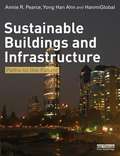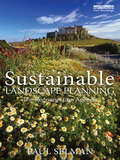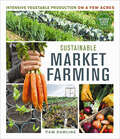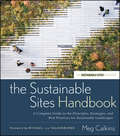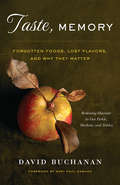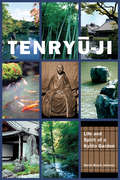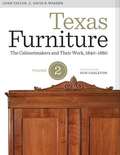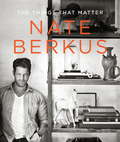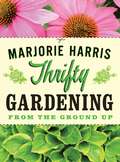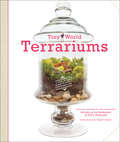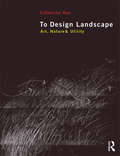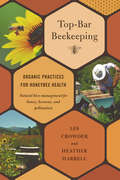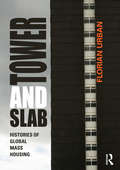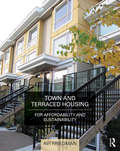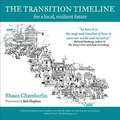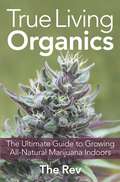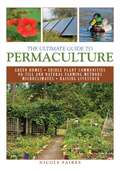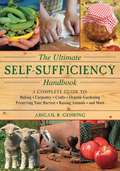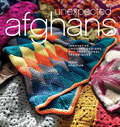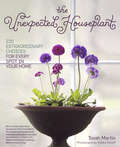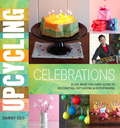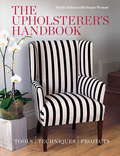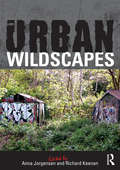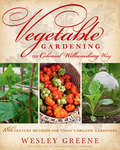- Table View
- List View
Sustainable Buildings and Infrastructure: Paths to the Future
by Annie Pearce Ltd Hanmiglobal Co Yong Han AhnConstruction is one of the biggest industries in the world, providing necessary facilities for human prosperity ranging from the homes in which we live to the highways we drive, the power plants that provide energy for our daily activities, and the very infrastructure on which human society is built. The construction sector, including the building sector, has among the largest potential of any industry to contribute to the reduction of greenhouse gas emissions. This ambitious and comprehensive textbook covers the concept of embedding sustainability across all construction activities. It is aimed at students taking courses in construction management and the built environment. Written in a lively and engaging style the book sets out the practical requirements of making the transition to a sustainable construction industry by 2020. Case studies are included throughout making the book both a core reference and a practical guide.
Sustainable Landscape Planning: The Reconnection Agenda
by Paul SelmanThis book takes as its starting point the need to examine critically the case for landscape reconnection. It looks at alleged disconnections and their supposed consequences. It explores the arguments about reconnecting the natural and human elements of whole landscapes. More broadly, it considers landscape as an arena within which science, humanities and professions can find common ground, and in which vivid social learning can occur about key social and environmental issues. It takes a dynamic view of landscape, in contrast to the popular image of timeless, traditional scenery. It accepts that even the most cherished cultural landscapes will change and, indeed, it views 'change drivers' as a potentially positive means of creating new connectivities between people and place. It recognises the growing interest in promoting resilience and ecosystem services across extensive landscapes - such as by creating new 'space' for water and wildlife.
Sustainable Market Farming: Intensive Vegetable Production on a Few Acres (Mother Earth News Books for Wiser Living)
by Pam DawlingAcross North America, an agricultural renaissance is unfolding. A growing number of market gardeners are emerging to feed our appetite for organic, regional produce. <P><P>But most of the available resources on food production are aimed at the backyard or hobby gardener who wants to supplement their family's diet with a few homegrown fruits and vegetables. Targeted at serious growers in every climate zone, Sustainable Market Farming is a comprehensive manual for small-scale farmers raising organic crops sustainably on a few acres. Informed by the author's extensive experience growing a wide variety of fresh, organic vegetables and fruit to feed the approximately one hundred members of Twin Oaks Community in central Virginia, this practical guide provides: Detailed profiles of a full range of crops, addressing sowing, cultivation, rotation, succession, common pests and diseases, and harvest and storage Information about new, efficient techniques, season extension, and disease resistant varieties Farm-specific business skills to help ensure a successful, profitable enterprise Whether you are a beginning market grower or an established enterprise seeking to improve your skills, Sustainable Market Farming is an invaluable resource and a timely book for the maturing local agriculture movement. Pam Dawling is a contributing editor with Growing for Market magazine. An avid vegetable grower, she has been farming as a member of Twin Oaks Community in central Virginia for over twenty years, where she helps grow food for around one hundred people on three and a half acres, and provides training in sustainable vegetable production.
The Sustainable Sites Handbook
by Meg CalkinsGet the definitive resource guide for sustainable site design, construction, and management. The Sustainable Sites Initiative (SITES) is transforming land design, development, and management practices across the United States with the first national rating system for sustainable landscapes. The Sustainable Sites Handbook features comprehensive and detailed information on principles, strategies, technologies, tools, and best practices for sustainable site design. Contributors to this book are some of the same experts that carefully shaped the SITES rating tool, ensuring thorough coverage of the broad range of topics related to sustainable site design. The Sustainable Sites Handbook offers in-depth coverage of design, construction, and management for systems of hydrology, vegetation, soils, materials, and human health and well-being. Focusing primarily on environmental site design and ecosystem services, this wide-ranging guide also covers issues of social equity, economic feasibility, and stewardship, which are crucial to the success of any sustainable site. Equally useful as a handbook for obtaining SITES credits or for the independent development of sustainable sites, The Sustainable Sites Handbook is an indispensible resource for practicing professionals in landscape architecture, landscape design, architecture, civil engineering, land planning, horticulture, ecology, environmental engineering, landscape contracting, and parks and recreation management.
Taste, Memory / Forgotten Foods, Lost Flavors, and Why They Matter
by David BuchananTaste, Memorytraces the experiences of modern-day explorers who rediscover culturally rich forgotten foods and return them to our tables for all to experience and savor. In Taste, Memoryauthor David Buchanan explores questions fundamental to the future of food and farming. How can we strike a balance between preserving the past, maintaining valuable agricultural and culinary traditions, and looking ahead to breed new plants? What place does a cantankerous old pear or too-delicate strawberry deserve in our gardens, farms, and markets? To what extent should growers value efficiency and uniformity over matters of taste, ecology, or regional identity?While living in Washington State in the early nineties, Buchanan learned about the heritage food movement and began growing fruit trees, grains, and vegetables. After moving home to New England, however, he left behind his plant collection and for several years stopped gardening. In 2005, inspired by the revival of interest in regional food and culinary traditions, Buchanan borrowed a few rows of growing space at a farm near his home in Portland, Maine, where he resumed collecting. By 2012 he had expanded to two acres, started a nursery and small business, and discovered creative ways to preserve rare foods. InTaste, MemoryBuchanan shares stories of slightly obsessive urban gardeners, preservationists, environmentalists, farmers, and passionate cooks, and weaves anecdotes of his personal journey with profiles of leaders in the movement to defend agricultural biodiversity. Taste, Memorybegins and ends with a simple premise: that a healthy food system depends on matching diverse plants and animals to the demands of land and climate. In this sense of place lies the true meaning of local food.
Tenryu-ji
by Norris Brock JohnsonThis illustrated study of Tenryuji, ranked number one among the five great Zen temples of Kyoto and a major destination for tourism and worship, weaves together history, design, culture, and personal reflection to reveal the inner workings of a great spiritual institution. Looking at Tenryuji's present as a mirror to its past, and detailing the famous pond and rockwork composition by renowned designer Muso Soseki, Norris Brock Johnson presents the first full-length "biography" of a Zen temple garden.Norris Brock Johnson is a professor of anthropology at the University of North Carolina in Chapel Hill and has been teaching and writing about Japanese temple gardens for over twenty years.
Texas Furniture: The Cabinetmakers and Their Work, 1840-1880
by Lonn Taylor David B. WarrenThe art of furniture making flourished in Texas during the mid-nineteenth century. To document this rich heritage of locally made furniture, Miss Ima Hogg, the well-known philanthropist and collector of American decorative arts, enlisted Lonn Taylor and David B. Warren to research early Texas furniture and its makers. After more than a decade of investigation, they published Texas Furniture in 1975, and it quickly became the authoritative reference on this subject. An updated edition, Texas Furniture, Volume One, was issued in the spring of 2012. Texas Furniture, Volume Two presents over 150 additional pieces of furniture that were not included in Volume One, each superbly photographed in color and accompanied by detailed descriptions of the piece's maker, date, materials, measurements, history, and owner, as well as an analysis by the authors. Taylor and Warren have also written a new introduction for this volume, in which they amplify the story of early Texas furniture. In particular, they compare and contrast the two important traditions of cabinetmaking in Texas, Anglo-American and German, and identify previously unknown artisans. The authors also discuss nineteenth-century Texans' desire for refinement and gentility in furniture, non-commercial furniture making, and marquetry work. And they pay tribute to the twentieth-century collectors who first recognized the value of locally made Texas furniture and worked to preserve it. A checklist of Texas cabinetmakers, which contains biographical information on approximately nine hundred men who made furniture in Texas, completes the volume.
The Things That Matter
by Nate BerkusDoes your home tell the story of who you are? In The Things That Matter, Nate Berkus shares intimate stories from his life, introduces us to people who influenced him and helped him forge his sense of style, and opens up about the remarkable experiences that have left him forever changed, all of which find expression in how he lives today. From his most cherished flea market finds, to his beloved books and photos, to the many extraordinary mementos he's collected in his travels, every piece defines who he's become and what endures in his world. Berkus invites readers into his own home as well as into twelve others, including a sleek steel-and-glass high-rise that soars above Chicago, a rustic cottage in the Hudson Valley, an ultra-chic atelier that maximizes every inch of space, a Greenwich Village townhouse that holds multiple art collections, and a study in meaningful minimalism in Marfa, Texas. The distinctive interiors beautifully displayed in this book offer revealing portraits of their owners' lives and the inspiring choices that have made them who they are today. The Things That Matter convincingly lays out Nate Berkus's philosophy that things do matter. Our homes tell our stories, they reflect the places we've been and the people we've loved along the way--and there can be no more beautiful design for living than that.From the Hardcover edition.
Thrifty Gardening: From the Ground Up
by Marjorie HarrisBestselling author and gardening columnist Marjorie Harris offers a timely and entertaining guide for gardeners at every stage of life. Whether you're moving into your first apartment or condo, upgrading to a house, or downsizing to smaller digs, Harris shares the best tips on how to create a beautiful garden for any space — all on a budget. The highly anticipated sequel to her popular book Thrifty: Living the Frugal Life with Style, The Thrifty Gardener marries Harris's passion for gardening with her thrifty lifestyle savvy so that everyone can create a natural oasis whatever their living situation is — and without breaking the bank.
Tiny World Terrariums: A Step-by-Step Guide to Easily Contained Life
by Michelle Inciarrano Katy MaslowTerrariums are a vibrant, unique way to inject a little greenery into any home. In Tiny World Terrariums, authors Katy and Michelle of Brooklyn’s celebrated Twig Terrariums offer step-by-step instructions for building your own, from selecting glass containers to layering soil and filtration to adding moss, succulents, and other plants. To give each terrarium a whimsical, personal touch, Katy and Michelle demonstrate how to use tiny figurines and toys to create to-scale scenes, such as a couple at their wedding, a CSI crime scene, and Central Park in springtime. Photos of gorgeous finished terrariums and detailed instructions will empower anyone—whether green-thumbed or not—to create their own Lilliputian worlds.
To Design Landscape: Art, Nature & Utility
by Catherine DeeTo Design Landscape sets out a distinctively practical philosophy of design, in accessible format. Based on the notion that landscape design is a form-based craft addressing environmental processes and utility, Dee establishes a framework for approaching such craft with modesty and ingenuity, using the concept of "aesthetics of thrift".Employing numerous case studies-as diverse as Hellerup Rose Garden in Denmark; Bloedel Reserve, Bainbridge Island, USA; Rousham Gardens, Oxfordshire, UK and Tofuku-ji, in Kyoto, Japan - to illustrate her ideas, the book is a beautiful portfolio of Dee's drawings, which are both evocative and to the point.The book begins with a 'Foundations' section, which sets out the basis of the approach. ?'Principles' chapters then elaborate eleven significant considerations applicable to any design project, regardless of context and scale. Following on, 'Strategies' chapters reinforce the principles, and suggest further ways of designing, adaptable to different conditions. Dee ends with a focus on 'Elements', case studies and verb lists providing sources for the designer to consider how the components - vegetation, water, terrain, structures, soils, weather, and the sky - ?might be engaged, mediated and joined.Catherine Dee’s book is for all those who would craft landscape, from the gardener, to the professional landscape architect, to the student of design
Top-Bar Beekeeping
by Heather Harrell Les CrowderBeekeepers Continue to Face Tremendous Challenges, from pests, diseases, pollution, climate change, and, in recent years, from the mysterious and devastating phenomenon known as Colony Collapse Disorder (CCD). Yet in backyards and on rooftops all over the world, top-bar hives are being used to raise bees successfully without antibiotics, miticides, or other chemical inputs.
Tower and Slab: Histories of Global Mass Housing
by Florian UrbanTower and Slab looks at the contradictory history of the modernist mass housing block - home to millions of city dwellers around the world. Few urban forms have roused as much controversy. While in the United States decades-long criticism caused the demolition of most mass housing projects for the poor, in the booming metropolises of Shanghai and Mumbai remarkably similar developments are being built for the wealthy middle class. While on the surface the modernist apartment block appears universal, it is in fact diverse in its significance and connotations as its many different cultural contexts. Florian Urban studies the history of mass housing in seven narratives: Chicago, Paris, Berlin, Brasilia, Mumbai, Moscow, and Shanghai. Investigating the complex interactions between city planning and social history, Tower and Slab shows how the modernist vision to house the masses in serial blocks succeeded in certain contexts and failed in others. Success and failure, in this respect, refers not only to the original goals – to solve the housing crisis and provide modern standards for the entire society – but equally to changing significance of the housing blocks within the respective societies and their perception by architects, politicians, and inhabitants. These differences show that design is not to blame for mass housing’s mixed record of success. The comparison of the apparently similar projects suggests that triumph or disaster does not depend on a single variable but rather on a complex formula that includes not only form, but also social composition, location within the city, effective maintenance, and a variety of cultural, social, and political factors.
Town and Terraced Housing: For Affordability and Sustainability
by Avi FriedmanRecent societal changes have brought about renewed interest from architects, town planners, housing officials and the public in terraces and townhouses. The small footprint that this style of house occupies allows a sustainable high density approach to habitation, slowing sprawl and creating energy-efficient affordable living. Townhouses have been used for hundreds of years, and their evolution is covered from their inception right up to the present day. With the changing demographics of buyers in mind, Avi Friedman details how the design of these houses can be adapted to keep-up with contemporary needs. Friedman uses a systematic approach to cover the many facets of townhouses from interior design and construction methods, to urban planning issues like adjusting to the site’s natural conditions, street configurations and open spaces. This approach creates a book which will be a valuable resource for those involved in the planning, design and creation of terraced and town houses. Over 150 detailed diagrams and plans, and eighty photos, illustrate the essential elements of this style of housing. In the final chapter, lessons learnt throughout the book are draw together in ten broad ranging case study projects, showing how the various aspects can be put into practice.
The Transition Timeline: For a Local, Resilient Future
by Shaun ChamberlinThe Transition Timeline lightens the fear of our uncertain future, providing a map of what we are facing and the different pathways available to us. It describes four possible scenarios for the UK and world over the next twenty years, ranging from Denial, in which we reap the consequences of failing to acknowledge and respond to our environmental challenges, to the Transition Vision, in which we shift our cultural assumptions to fit our circumstances and move into a more fulfilling, lowerenergy world. The practical, realistic details of this Transition Vision are examined in depth, covering key areas such as food, energy, demographics, transport and healthcare, and they provide a sense of context for communities working towards a thriving future. The book also provides a detailed and accessible update on climate change and peak oil and the interactions between them, including their impacts in the UK, present and future. Use it. Choose your path, and then make that future real with your actions, individually and with your community. As Rob Hopkins outlines in his foreword, there is a rapidlyspreading movement addressing these challenges, and it needs you.
True Living Organics
by The RevThe only organics grow guide is also the only book that shows how to change an existing grow room to an all-natural, synthetic-free, living, breathing cannabis cultivation space. Written in the accessible, easy-to-follow style that's won The Rev so many followers, this book sifts through the jargon surrounding organic marijuana growing and gets straight to the heart of the matter: the living soil. True Living Organics provides several different ways to create a high-quality living medium for marijuana plants. Dispensing with the basics of how to grow pot, this guide instead gives the reader a new education on what cannabis plants really need and the best way to give it to them. With over 200 color photos illustrating every topic, this book is as easy to use as it is insightful.
The Ultimate Guide to Permaculture: Permaculture For Beginners (Ultimate Guides)
by Nicole FairesPermaculture is an important but often misunderstood method of growing food and building homes in a manner that works with nature, rather than against it, to create beautiful, healthy, and useful gardens. Blending ecology, organic agriculture, green home design, appropriate technology, and biology can be confusing and overwhelming, but The Ultimate Guide to Permaculture simplifies this vast field for practical application. This is a hands-on guide, taking the beginner through each step of the design process, so that anyone can apply permaculture principles to their own life. While the principles are simple, the in-depth topics cover every aspect of permaculture, including:- Building green homes and passive solar design - Growing edible plant communities and forest gardens - Using no-till and natural farming methods - Creating microclimates for extended growing seasons - Raising livestock with ecological foraging techniques This is a common-sense approach to sustainable living that creates a self-sufficient and low-effort home for the people that live there, whether in the city or the country. The Ultimate Guide to Permaculture isn't a philosophy book, or a dissertation on theory. It is a step-by-step, complete guide to every aspect of permaculture.
The Ultimate Self-Sufficiency Handbook: A Complete Guide to Baking, Crafts, Gardening, Preserving Your Harvest, Raising Animals, and More (Self-Sufficiency Series)
by Abigail R. GehringThis compact guide provides advice, tips, and step-by-step instructions for hundreds of projects, offering the entire family the tools they need to make the shift toward self-sufficient living. Readers will learn to dip candles, bake bread, make maple syrup, start a vineyard, and much more. With special features for young homesteaders, this is an essential family guide to self-sufficient living. - Bake Pies, Cakes, and Bread- Grow Vegetables yy Raise Chickens - Keep Bees - Preserve Your Harvest- Cure Meats - Build a Treehouse- Spin Wool - Make a Toboggan - And Much More!
Unexpected Afghans: Innovative Crochet Designs with Traditional Techniques
by Robyn ChachulaUnexpected Afghans presents 29 innovative interpretations of a favorite at-home essential. From best-selling author Robyn Chachula comes an in-depth look into crocheting traditional afghans using contemporary techniques, colors and patterns.Expert designers including Kristin Omdahl, Kathy Merrick, Kimberly McAlindin, and many more, provide an abundance of fresh patterns and projects that are perfect for new and advanced crocheters as they start out beginner-friendly and become more complex, allowing a crocheter to build skills and confidence. Designers at any level will enjoy: • A detailed technique's workshop in every chapter including cables, motifs, color, lace, and Tunisian crochet. • Helpful tips from designers for working through each afghan project. • Easy-to-follow charts and diagrams. Along with tons of beautiful afghan projects for all skill levels, you'll find many of your favorite designer's biographies--giving you an exploration into their inspiration.
The Unexpected Houseplant: 220 Extraordinary Choices for Every Spot in Your Home
by Tovah MartinIt's time for plant lovers to dust off their houseplants, update their image, and discover just how exciting, trendy, and crucial plants can be in the home.The Unexpected Houseplant, by renowned plant authority Tovah Martin, isn't your typical, old-fashioned, dowdy houseplant book. Martin's approach is revolutionary—picture brilliant spring bulbs by the bed, lush perennials brought in from the garden, quirky succulents in the kitchen, even flowering vines and small trees growing beside an easy chair. Martin brings an evangelist's zeal to the task of convincing homeowners that indoor plants aren't just a luxury—they're a necessity. In addition to design flair, houseplants clean indoor air, which can be up to ten times more polluted. Along with loads of visual inspiration, readers will learn how to make unusual selections, where to best position plants in the home, and valuable tips on watering, feeding, grooming, pruning, and troubleshooting, season by season.
Upcycling Celebrations: A Use-What-You-Have Guide to Decorating, Gift-Giving & Entertaining
by Danny SeoDanny Seo is America’s leading lifestyle authority on modern, eco-friendly living. In his last book, Upcycling, Danny demonstrated how to create beautiful things with the stuff you already have. Now he returns with 100 more projects-this time focused specifically on parties and holidays. Whether you’re making dramatic party favors for New Year’s Eve, giving a unique birthday gift, creating paper lanterns for a summer BBQ, or planning the Thanksgiving table, Danny shows how you can transform the ordinary into striking one-of-a-kind objects that will make every occasion a little more festive.
The Upholsterer's Handbook
by Nicole Fulton Stuart WestonIn eye-capturing style The Upholsterer's Handbook offers everything you need and more, in order to prepare and inspire you to create beautifully upholstered furniture. The upholstered pieces range in skill level from simple seats to more complex items such as a button-back chair. Various styles of furniture are covered, from classic and elegant to other more styled and designer pieces.The Upholsterer's Handbook opens with sections on sourcing furniture, tools and materials, and choosing fabrics - including finishes and trimmings, which are often the key to the success of a piece. With special photography throughout, basic techniques are illustrated step-by-step, from stripping back to top stuffing to making cushions. 18 stunning projects are featured with varying skill levels, covering such diverse items as a G-plan chair, a sofa, a '70s flower-shaped stool, dining chairs, and headboards. Throughout Nicole Fulton demonstrates techniques using linen, satin, velvet, leather, cowhide, and other fabrics that give the furniture a unique contemporary look.
The Upholsterer's Handbook
by Nicole Fulton Stuart WestonIn eye-capturing style The Upholsterer's Handbook offers everything you need and more, in order to prepare and inspire you to create beautifully upholstered furniture. The upholstered pieces range in skill level from simple seats to more complex items such as a button-back chair. Various styles of furniture are covered, from classic and elegant to other more styled and designer pieces.The Upholsterer's Handbook opens with sections on sourcing furniture, tools and materials, and choosing fabrics - including finishes and trimmings, which are often the key to the success of a piece. With special photography throughout, basic techniques are illustrated step-by-step, from stripping back to top stuffing to making cushions. 18 stunning projects are featured with varying skill levels, covering such diverse items as a G-plan chair, a sofa, a '70s flower-shaped stool, dining chairs, and headboards. Throughout Nicole Fulton demonstrates techniques using linen, satin, velvet, leather, cowhide, and other fabrics that give the furniture a unique contemporary look.
Urban Wildscapes
by Anna Jorgensen Richard KeenanUrban Wildscapes is one of the first edited collections of writings about urban ‘wilderness’ landscapes. Evolved, rather than designed or planned, these derelict, abandoned and marginal spaces are frequently overgrown with vegetation and host to a wide range of human activities. They include former industrial sites, landfill, allotments, cemeteries, woods, infrastructural corridors, vacant lots and a whole array of urban wastelands at a variety of different scales. Frequently maligned in the media, these landscapes have recently been re-evaluated and this collection assembles these fresh perspectives in one volume. Combining theory with illustrated examples and case studies, the book demonstrates that urban wildscapes have far greater significance, meaning and utility than is commonly thought, and that an appreciation of their particular qualities can inform a far more sustainable approach to the planning, design and management of the wider urban landscape. The wildscapes under investigation in this book are found in diverse locations throughout the UK, Europe, China and the US. They vary in scale from small sites to entire cities or regions, and from discrete locations to the imaginary wildscapes of children’s literature. Many different themes are addressed including the natural history of wildscapes, their significance as a location for all kinds of playful activity, the wildscape as ‘commons’ and the implications for landscape architectural practice, ranging from planting interventions in wildscapes to the design of the urban public realm on wildscape principles.
Vegetable Gardening the Colonial Williamsburg Way: 18th-Century Methods for Today's Organic Gardeners
by Wesley GreeneFrom the nation's foremost historical preservation site comes a guide to traditional—and still relevant—methods and advice for planting and tending a productive vegetable gardenIn a colonial-style garden, the broccoli is purple and "turkey" cucumbers grow to three feet long; oiled paper predates plastic for sheltering spring plants; and fermenting manure warms the seedlings. Finding inspiration and value in 18th-century plants, tools, and techniques, the gardeners at Colonial Williamsburg have discovered that these traditional vegetable-growing methods are perfectly at home in today's modern organic gardens. After all, in the 18th century, organic gardening was the only type of gardening and local produce the only produce available.Author Wesley Greene founded the Colonial Garden in Colonial Williamsburg's Historic Area in 1996. He and his colleagues have painstakingly researched the ways the colonists planted and tended their vegetable and herb beds, most of which are more relevant than ever. Along with historical commentary and complete growing instructions for 50 delicious vegetables, including colonial varieties still available today, gardeners and folklorists will find weather-watching guidelines, planting techniques, and seedsaving advice for legumes, brassicas, alliums, root crops, nightshades, melons, squash, greens, and other curious and tender produce.
